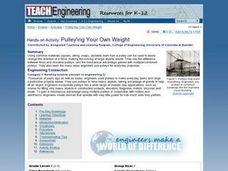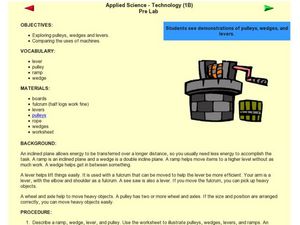Curated OER
Simple Machines III - Pulleys
The principles behind pulleys, levers, and simple machines are the focus of a science instructional activity. In it, learners take part in a whole-class activity. There are two groups of pupils who each must lift objects with fixed...
Curated OER
Levers and Pulleys
Seventeen pages of material leave you well-prepared to carry out this lesson on levers and pulleys. Photos and diagrams make the instructions clear; resource links provide additional information. The missing aspects of this teacher's...
Magic of Physics
Moving Toy Mechanisms
Who says playing around in class is a bad idea? Precocious physicists engage in building mechanisms that include cams, gears, pulleys, and levers using an interactive lesson. After completing toy tutorials about each topic, users build a...
Curated OER
Simple Machines: Pulleys
Students observe and analyze how pulleys work and how a double pulley can make work easier. In small groups they use a fixed pulley system and a double pulley system and draw a picture of how their pulley system functions. Students...
Curated OER
Pulleys
In this simple machines worksheet, middle schoolers learn about pulleys. They then answer the 11 questions on the page. The answers are on the last page of the packet.
Scholastic
Study Jams! Simple Machines
Here is a tri-faceted resource that has a slide show, a quiz, and a vocabulary list that you can use to teach simple machines. Six machines are introduced: wheels and axles, planes, levers, pulleys, wedges, and screws. Slides contain...
Curated OER
TE Activity: Pulley'ing Your Own Weight
Students experiment with common objects such as spools, string and soap to determine how pulleys make it easier to move large objects. They look at the difference between fixed and movable pulleys. They examine the many uses engineers...
Curated OER
Is a Pulley a Special Kind of Lever?
Fifth graders use information from their text to read and discuss pulleys and levers. They examine a top sketch of the arrangement of a fixed pulley. Working in groups, 5th graders perform experiments to test the effect of using a pulley...
Curated OER
Powerful Pulleys
Students explore the building of a pyramid and how pulleys were used to change the direction of applied force. They demonstrate the mechanical advantage of using a pulley and apply it to modern engineering.
Curated OER
Pulleys
Middle schoolers determine how to tell the difference between a simple system and a complex pulley system. Using pulleys, students build simple pulley systems to demonstrate the mechanical advantages of pulleys.
Curated OER
Levers, Pulleys, Incline Planes
In this pulleys, levers and incline planes worksheet, students answer 22 questions about output force, energy loss, and net force on pulleys, levers and incline planes.
Curated OER
A Simple Block and Tackle Pulley Demonstration
Students investigate the scientific concept of mechanical advantage. They construct their own system with the use of a simple broomstick. Then the demonstration is done to show how the mechanical advantage is used to move a load.
Curated OER
Inclined Plane and Pulley
Students describe how inclined plane and pulleys make work easier. In this physics lesson, students calculate work done and mechanical advantage of both simple machines. They collect data from the experiment and construct graphs.
National Park Service
Pulley Systems Used at Fort McHenry
What a great opportunity to integrate science into your lesson plan on the War of 1812! Discover how pulley systems were used to move 1,000 lb. cannons at the Battle of Fort McHenry, and to raise the flag that would inspire Francis...
Curated OER
Simple Machines
Here is an inventive plan that should get your young scientists excited! In it, groups of pupils test out the work done by six different simple machines. The machines are: the wedge, the lever, the inclined plane, the pulley, the screw,...
Curated OER
Pull(ey)ing The Science Out (Or Pulleys)
Students investigate how the number of pulleys affect the difficulty or ease of pulling an object up. They watch a demonstration that shows the work done by one pulley and two pulleys. After watching the demonstration, the students break...
Teach Engineering
Machines and Tools (Part 2)
Which pulley system will give us a whale of a good time? Teams compare the theoretical and actual mechanical advantages of different pulley systems. They then form a recommendation for how to move a whale from an aquarium back to the ocean.
Curated OER
Simple Machines III - Pulleys
Fourth graders are introduced to a spring scale to show that the forces on both sides of the pulley are the same. They break into groups to lift objects with fixed pulleys and with multiple looped pulleys and then measure the force...
Curated OER
Simple Machines-Pulleys
Third graders understand what a pulley is and how it works. In this simple machines, pulley lesson students experiment with broom sticks creating a pulley. Students observe how the pulley moves in its different trials.
Curated OER
Investigating Pulleys
Young scholars investigate pulleys and see how they have a mechanical advantage in lifting heavy loads. In this pulley lesson plan students make a hypothesis, complete and experiment then complete a worksheet.
Curated OER
Forces That Move Objects
In this forces worksheet, students complete a graphic organizer by writing in examples of simple machines that can apply forces to move objects.
Curated OER
Welcome to the Wonderful World of Machines
Designed for a lower elementary school classroom, this presentation on simple machines is a wonderful way to introduce this topic. The resource begins by identifying and defining the six types of simple machines, and then goes on to...
Curated OER
Applied Science - Technology (1B) Pre Lab
First graders explore simple machines. In this technology lesson, 1st graders review pulleys, levers, wedges, and ramps. They experiment with lifting items with and without these simple machines.
Curated OER
Applied Science - Technology (2A) Lab
Second graders experiment with simple machines. In this machine lesson, 2nd graders go to different labs to see examples of a lever, inclined plane, wedge, pulley, gears, and wheel and axle. They discuss how a machine makes work a lot...























